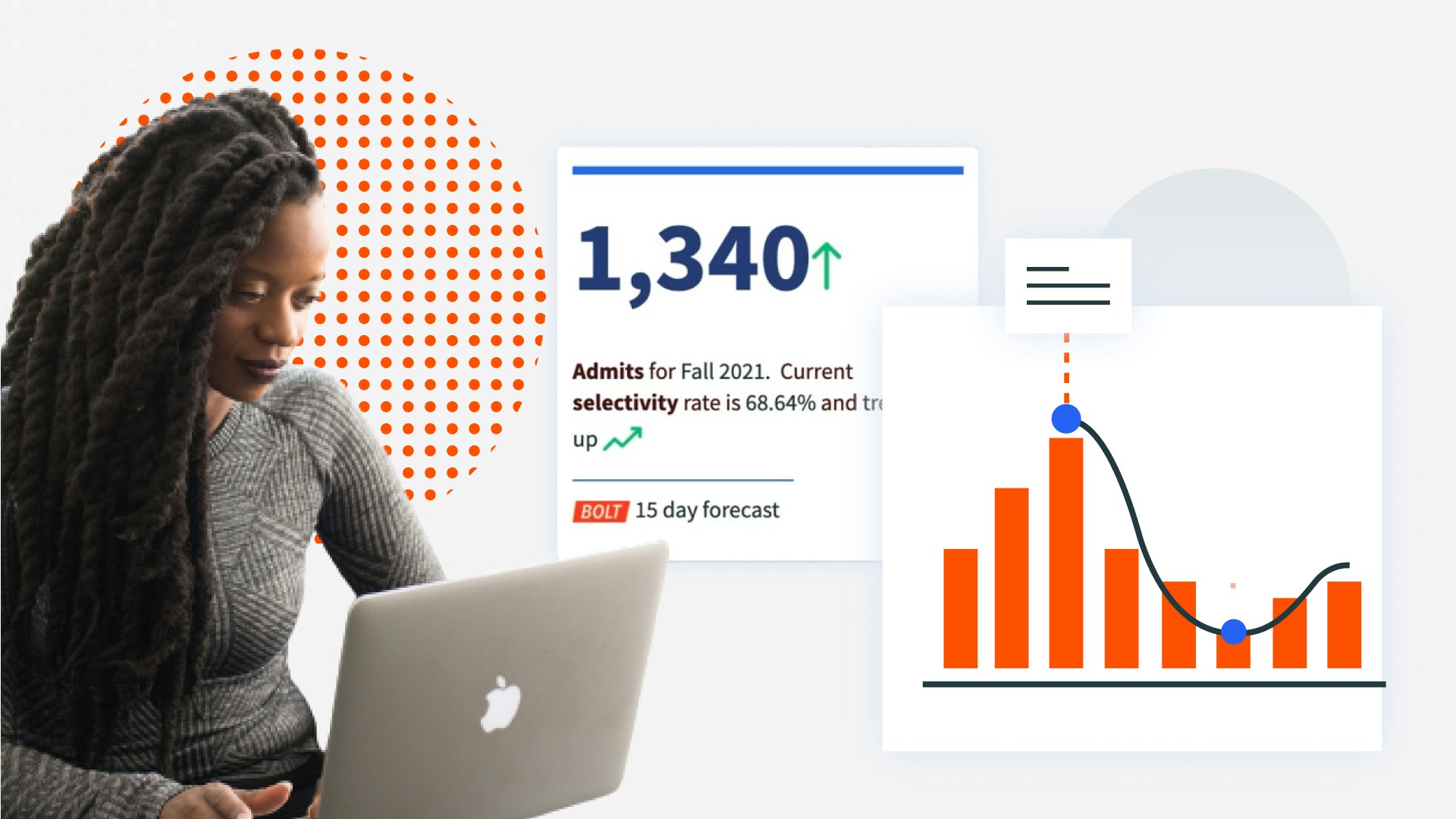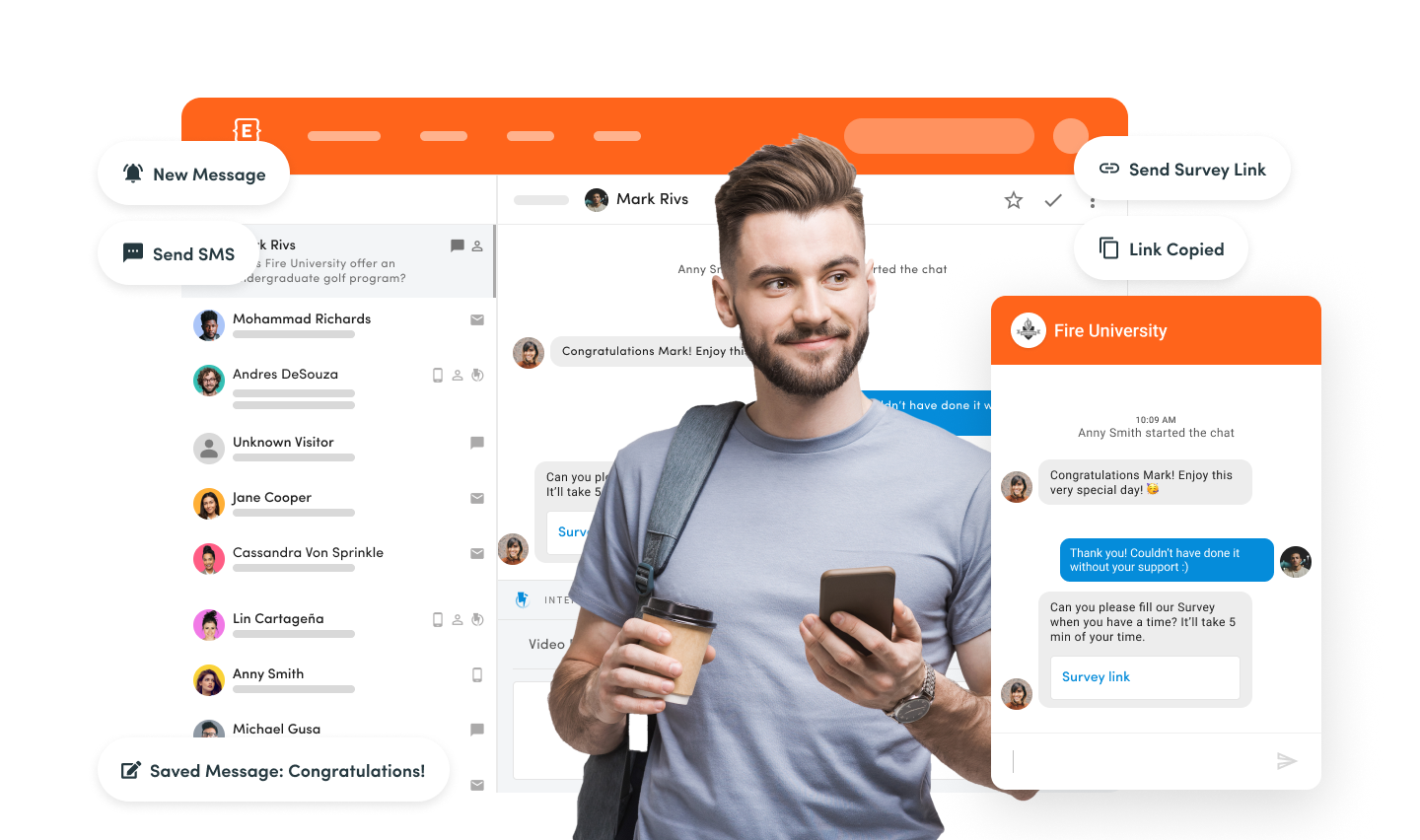How to Establish Admissions Goals and Objectives at Your College
by Erin Fields · Updated Sep 13, 2024
In the face of declining college and university enrollment across the country, admissions teams need to have a clear focus when recruiting incoming classes. By getting specific and clear on new objectives, it’s easier to unite your entire department and ensure that everyone’s work contributes to the same goal.
Having admissions goals and objectives means that you’re willing to plan for different types of growth. Whether that means increasing enrollment targets each year or providing additional professional development and training to recruiting staff, objectives create positive ripple effects throughout an organization or campus community.
In this article, we’ll provide a comprehensive look at why your team should incorporate the right admissions goals and objectives into your master enrollment plan. We’ll also break down specific examples and show how a CRM can help you achieve your goals.

Why Should You Have Admissions Goals?
Admissions goals are an integral part of your college or university’s growth strategy. Without a strategic plan for improving or accelerating your admissions process, it’s challenging to get ahead of declining admissions trends nationwide.
Your team or department should also have clear admissions goals to tackle the following scenarios.
- Communicate with other university teams and key players. Other teams and staff rely on admissions goals for accurate planning. For example, academic programs need to know how many incoming students to expect for correct course planning.
- Report to executive leadership. Upper-level campus leaders may want to have visibility on long-range plans for increasing the number of students. Clear goals and objectives make it easy to answer related questions and to stay accountable to broader goals.
- Equip recruiting staff with the necessary tools. Recruiters and other student-facing staff members need to know how to interact with potential students. Transparent information from admissions can help them meet necessary quotas while gaining the skills they need to recruit with a “student-first” mindset.
5 Examples of Admissions Goals and Objectives
If you’re not sure where to start when creating admissions goals and objectives for the upcoming term or academic year, we’ve narrowed it down for you.
While some goals may be specific to the technology or strategies you employ, others may focus on student interactions and interpersonal skills.
Remember—there’s no limit to the number or type of goals you set for the admissions program at your university. As long as the goals are specific, actionable, and relevant, you’ll be on the road to success.
1. Leverage Student Data More Effectively
Admissions staff typically have access to a significant amount of student data. This information is provided during the initial inquiry stages or when a prospective student submits a new application. Such data can be generic contact information, or it might include detailed insights into what a student wants from their holistic college experience.
Admissions officers and other enrollment personnel have two choices: store this data, or create actionable steps to leverage it more fully. An example of an action step would be connecting a student who is interested in a business degree to the appropriate college or program leadership.
As an annual goal, admissions offices should take a careful look at how they are collecting, storing, and using data about incoming students. A practical goal would be to take advantage of this information and connect to a greater number of students prior to the initial acceptance deadline.

Get a Demo of Element451
Let learners lead the way. Get everything you need to build lasting relationships with today’s digital-first students.
See it in Action
2. Create Personalization Opportunities
Personalization in higher education is one of the key ways that modern colleges and universities are looking to attract and retain students. A personalized approach means that students aren’t simply considered a number in line. Instead, each interested prospect receives information that is uniquely tailored to their own preferences.
A few examples of student personalization include:
- Directing messages to the student’s unique name and address
- Providing tailored and customized reminders about important dates or steps
- Placing the student in marketing tracks that are unique to their expressed interests
If you currently personalize some communications, how would your admissions team be able to take this a step further? Are you able to effectively measure the specific impact that personalization has on a student’s willingness to accept, attend, or remain enrolled?
3. Recruit a Set Number of Students During Early Acceptance
Many colleges and universities operate with varied enrollment deadlines. Some of these deadlines offer benefits to students who are offered admission and agree to enroll early. These students are considered first in line and begin the process of enrolling before other students are offered standard acceptance.
How does your institution leverage and take advantage of early acceptance? Does your team view this time period with excitement or hesitation?
If your school is in a place where more enrollments are needed, consider ways to cast a positive light on early acceptance. For instance, you might advertise a better selection of intro-level courses, a small scholarship, branded swag, or perks that students can use once they arrive on campus for the new semester.
4. Host In-Person Opportunities for Prospective Families
Although the pandemic ushered in a wave of virtual campus tours and admissions events, students and families are slowly making their way back to in-person college exploration. If you’re responsible for planning admissions and inquiry events, consider how you can increase these opportunities both safely and practically.
In-person campus tours and activities are beneficial for creating excitement and encouraging students to submit new applications while they’re physically on campus. As an admissions team, strive to incorporate more of these throughout the year. Train staff on how to interact, answer questions and present the most appealing parts of your campus.
5. Run Targeted Marketing Campaigns to Potential Students
Modern students are digitally savvy. They’re likely to conduct college research online, engage with prospective schools on social media, and participate in online activities. As a result, admissions teams should build goals around digital marketing strategies.
A set of goals could include running targeted ads or testing retargeting campaigns for prospective students who have visited your school’s website but haven’t moved forward in the admissions process. You could also set an objective budget for social media ads and gather data on how those ads performed.
If this is new territory, be generous and gracious with your goal-setting. The more solid marketing data you can gather at first, the more specific you can be with your goals in future academic years.
Leveraging a CRM Platform to Help Reach Objectives
A student engagement CRM (customer relationship management) platform can be the missing piece of your admissions goal-setting puzzle. The right platform can help you automate, track, and measure your goals more accurately.
On top of having better data about performance, you can also see what’s already working well in terms of recruitment and enrollment. With organized and reliable data, admissions leadership can be better equipped to create strategies that play to a school’s strength.
A CRM tool like Element451 also has personalization built right in. Personalization features make it easier to track student progress and communicate with students from the moment of decision all the way through graduation. In doing so, you can ensure that your admissions goals are not short-lived but that they have a long-term impact.

Listen to Mission: Admissions
Jeremy Tiers sits down with industry leaders and difference makers from both inside and outside of Higher Ed. You'll walk away with advice, tips and strategies you can apply in your day-to-day life.
Tune In
Design a Goal-Oriented Process
With the level of competition among higher education institutions today, now is the time to set attainable and specific goals to help your admissions team find success.
Book your Element451 demo to discover how a student-focused CRM platform can help you meet and scale your admissions goals this year.

About Element451
Boost enrollment, improve engagement, and support students with an AI workforce built for higher ed. Element451 makes personalization scalable and success repeatable.
Categories
New Blog Posts

The Definitive Guide
AI in Higher Education
Bridge the gap between the latest tech advancements and your institution's success.
Useful Links
Related Articles

Talk With Us
Element451 is the only AI Workforce Platform for higher education. Our friendly experts are here to help you explore how Element451 can improve outcomes for your school.
Get a Demo








